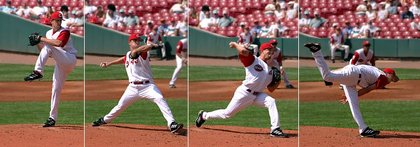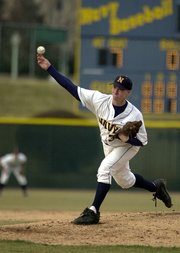Pitcher
|
|
- This article is about the sport of baseball. For the container, see pitcher (container).
In baseball, the pitcher is the player who throws the baseball from the pitcher's mound toward the catcher to begin each play, with the goal of retiring a batter who attempts to either make contact with it or draw a walk. In the numbering system used to record defensive plays, the pitcher is assigned the number 1.
In most cases, the object of a pitch is to deliver the ball to the catcher without allowing the batter to hit the ball. The ball is delivered in such a way that the batter either can't hit a pitch through the strike zone or is compelled to swing at a pitch outside of the strike zone. If the batter elects not to swing at the pitch, it is called a strike if the ball passes through the strike zone and a ball otherwise.
Nearly all action during a game is centered around the pitcher for the defensive team. A pitcher's particular style and skill heavily influences the dynamics of the game and will often determine the victor.
The type and sequence of pitches chosen depends upon the particular situation in a game. Because pitchers and catchers must coordinate each pitch, a system of hand signals are used by the catcher to communicate choices to the pitcher, to which the pitcher either vetoes or accepts.
Keeping a foot on the pitcher's rubber at the center of the pitcher's mound, which is 60 feet 6 inches from home plate, the pitcher throws the baseball to the catcher, who is positioned behind home plate and catches the ball. Meanwhile, a batter stands in the batter's box at one side of the plate, and attempts to bat the ball safely into fair play.
Although the object and mechanics of pitching remain the same for all pitchers, pitchers may be classified according to their roles and effectiveness. The starting pitcher begins the game and he may be followed various relief pitchers, such as the long reliever, the left-handed specialist, the setup man, and/or the closer.
Famous past Major League Baseball pitchers include Cy Young, Christy Mathewson, Walter Johnson, Sandy Koufax, Steve Carlton, and Nolan Ryan. Famous current pitchers (as of 2004) include Roger Clemens, Randy Johnson, Greg Maddux, Johan Santana, and Pedro Martinez.
| Contents |
Pitching in a game
Baseball_p.png
Effective pitching is vitally important in baseball. In baseball statistics, for each game, one pitcher will be credited with winning the game, and one pitcher will be charged with losing it. However, pitching is also physically demanding, especially if the pitcher is throwing with maximum effort. A full game usually involves 120-170 pitches thrown by each team, and most pitchers begin to tire before they reach this point. As a result, the pitcher who starts a game often will not be the one who finishes it, and he may not be recovered enough to pitch again for a few days. The act of throwing a baseball at high speed is very unnatural to the body and somewhat damaging to human muscles, thus pitchers are very susceptible to injuries, soreness, and general pain.
Teams have devised two strategies to address this problem: rotation and specialization. To accommodate playing nearly every day, a team will include a group of pitchers who start games and rotate between them, allowing each pitcher to rest for a few days between starts. Also, teams have additional pitchers reserved to replace that game's starting pitcher if he tires or proves ineffective. These players are called relief pitchers, relievers, or collectively the bullpen. The relief pitchers often have even more specialized roles, and the particular reliever used depends on the situation. Many teams designate one pitcher as the closer, a relief pitcher specifically reserved to pitch the final inning or innings of a game when his team has a narrow lead, in order to preserve the victory. Generally, relief pitchers pitch fewer innings and throw fewer pitches than starting pitchers, but may be able to pitch more frequently without needing multiple days to recover.
| Missing image Baseball_pitch_delivery.jpg Delivery of the baseball from the pitcher to catcher |
A skilled pitcher often throws a variety of different pitches in order to prevent the batter from hitting the ball well. The most basic pitch is a fastball, where the pitcher throws the ball as hard as he can. Some pitchers are able to throw a fastball at a velocity of over 100 miles per hour (160 km/h). Other common types of pitches are the curveball, slider, changeup, forkball, split-fingered fastball, and knuckleball. These generally are intended to have unusual movement or deceive the batter as to the rotation or velocity of the ball, making it more difficult to hit. Very few pitchers throw all of these pitches, but most use a subset or blend of the basic types. Some pitchers also release pitches from different arm angles, making it harder for the batter to pick up the flight of the ball. (See List of baseball pitches.)
After the ball is pitched
The pitcher's duty doesn't cease after he pitches the ball. He has several standard roles at that point. The pitcher must attempt to field any balls coming up the middle, and in fact a Gold Glove Award is reserved for the pitcher with the best fielding ability. He must also cover first base on balls hit to the right side, since the first baseman might be fielding them. On passed balls and wild pitches, he covers home-plate when there are runners on. Also, he generally backs up throws to home plate.
Significant pitchers
Baseball Hall of Fame members
Grover Cleveland Alexander - Chief Bender - Mordecai "Three Finger" Brown - Jim Bunning - Steve Carlton - Jack Chesbro - John Clarkson - Stan Coveleski - Candy Cummings - Leon Day (Negro Leagues) - Dizzy Dean - Martin Dihigo (also 2B/OF; Negro Leagues) - Don Drysdale - Dennis Eckersley (reliever) - Red Faber - Bob Feller - Rollie Fingers (reliever) - Whitey Ford - Bill Foster (Negro Leagues) - Rube Foster (also manager and executive; Negro Leagues) - Pud Galvin - Bob Gibson - Lefty Gomez - Clark Griffith (also manager and owner) - Burleigh Grimes - Lefty Grove - Jesse Haines - Waite Hoyt - Carl Hubbell - James "Catfish" Hunter - Ferguson Jenkins - Walter Johnson - Addie Joss - Tim Keefe - Sandy Koufax - Bob Lemon - Ted Lyons - Juan Marichal - Rube Marquard - Christy Mathewson - Joe McGinnity - Hal Newhouser - Kid Nichols - Phil Niekro - Satchel Paige (Negro Leagues) - Jim Palmer - Herb Pennock - Gaylord Perry - Eddie Plank - Charles "Old Hoss" Radbourn - Eppa Rixey - Robin Roberts - Bullet Joe Rogan (Negro Leagues) - Red Ruffing - Amos Rusie - Babe Ruth (also RF) - Nolan Ryan - Tom Seaver - Hilton Smith (Negro Leagues) - Warren Spahn - Albert Spalding (also manager and executive) - Don Sutton - Dazzy Vance - Rube Waddell - Ed Walsh - Monte Ward (also shortstop) - Mickey Welch - Hoyt Wilhelm (reliever) - Smokey Joe Williams (Negro Leagues) - Vic Willis - Early Wynn - Cy Young
Other noteworthy pitchers
Bert Blyleven - Bob Caruthers - Roger Clemens (*) - David Cone - Roy Face (reliever) - Wes Ferrell (also OF and pinch-hitter) - John Franco (*) (reliever) - Eric Gagne (*) (reliever) - Tom Glavine (*) - Dwight Gooden - Rich "Goose" Gossage (reliever) - Ron Guidry - Orel Hershiser - Trevor Hoffman (*) (reliever) - Tommy John - Randy Johnson (*) - Jim Kaat - Greg Maddux (*) - Firpo Marberry - Pedro Martinez (*) - Carl Mays - Jack Morris - Billy Pierce - Jeff Reardon (reliever) - Dick Redding (Negro Leagues) - Dan Quisenberry (reliever) - Lee Smith (reliever) - Bruce Sutter (reliever) - Luis Tiant
(*) active


